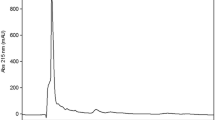Abstract
Inoculation of different plant wastes with microorganisms resulted in a release of maximum reducing sugars (33%) from sugar-cane leaves when subjected toPenicillium oxalicum. Maximum protein was formed from sugar-cane bagasse inoculated withAspergillus fumigatus. Association of sugar-cane leaves withP. oxalicum showed the highest digestibility. The use of such microorganisms may help to provide additional and valuable proteins ultimately for human use.
Similar content being viewed by others
References
Aaronson S.:Experimental Microbial Ecology, pp. 236. Academic Press, New York-London 1970.
Abd-Alla M.H., Omar S.A., Abd El-Wahab A.M.: The role of cellulose-decomposing fungi in nitrogenase activity ofAzotobacter chroococcum.Folia Microbiol.37, 215–218 (1992).
Bisaria V.S., Ghose T.K.: Biodegradation of cellulosic materials. Substrates, microorganisms, enzymes and products.Enzyme Microb. Technol.3, 90–104 (1981).
Chahal D.S., Moo-Young M., Dhillon G.S.: Bioconversion of wheat straw and wheat components into single cell protein.Canad. J. Microbiol.25, 793–800 (1979).
Coughlan M.P.: The properties of fungal and bacterial cellulases with comment on their production and application.Biotechnol. Genet. Eng. Rev.3, 99–109 (1985).
El-Nowawy A.S., El-Rayyes A.S., Daher R., Tawheed A.: Bioconversion of cellulose wastes.Kuwait Inst. Sci. Res. 1st Arab Gulf Conf. Biotechnology and Applied Microbiology, Riyadh (Saudi Arabia) 1984.
Fan L.T., Lee Y.H., Gharpuray M.M.: The nature of lignocellulose and their pretreatments on the enzymatic hydrolysis, pp. 157–187 in A. Fiechter (Ed.):Advances in Biochemical Engineering. Springer Verlag New York 1982.
Han Y.W.: Microbial utilization of straw.Adv. Appl. Microbiol23, 119–124 (1978)
Iyo A.H., Antai S.P.: Effects of different nitrogen sources on lignocellulose degradation and APPL production.Lett. Appl. Microbiol.7, 75–78 (1988).
Iyo A.H., Antai S.P.: Protein enrichment of lignocellulose resulting from the growth of twoStreptomyces strainsW. J. Microbiol. Biotechnol.7, 624–625 (1991).
Kerr J.J., Kerr R.D., Benner R.: Isolation of a bacterium capable of degrading peanut hull lignin.Environ. Microbiol.46, 1201–1206 (1983).
Kirk T.K., Harkin J.M.: Lignin biodegradation and bioconversion of wood.Alche Symp. Ser.69, 133 (1973).
Miller G.L.: Dinitrosalicylic acid reagent for determination of reducing sugar.Analyt. Chem.193, 426–428 (1959).
Njoku C.C., Antai S.P.: Lignocellulose degradation and crude protein formation by threeStreptomyces strains.Lett. Appl. Microbiol.4, 133–136 (1987).
Rice W.A.: Influence of nitrogen content of straw amendments on nitrogenase activity in waterlogged soil.Soil. Biol. Biochem.11, 187–191 (1979).
Stewart C., Walsh J.H.: Cellulolytic activity of pure and mixed cultures of fungi.Trans. Brit. Mycol. Soc.58, 527–531 (1972).
Author information
Authors and Affiliations
Rights and permissions
About this article
Cite this article
Abd-Alla, M.H., Mahmoud, A.L.E. Biodegradation of plant wastes to sugars and protein by microorganisms. Folia Microbiol 39, 222–224 (1994). https://doi.org/10.1007/BF02814652
Received:
Issue Date:
DOI: https://doi.org/10.1007/BF02814652




